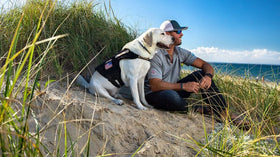
Great ways to predict your dog’s health: know the signs
We all worry about our furry friends, don’t we? We want our dogs and cats to always be healthy, and live long happy lives. Sometimes your pet will give you obvious signs of distress, but other times the signs are more subtle.
In either case, you should always consult with a veterinarian at the first sign of concern. Hopefully, we can give you some things to look for so you can stay ahead of your pet’s health. In this particular blog we’ll focus on dogs, but many of the same symptoms can occur in cats.
DISPELLING THE MYTH
 Before we get into potential signs of concern or sickness, let’s address an old myth: you cannot tell the health of a dog by its nose. A dog could have a dry or warm nose and be perfectly healthy. Conversely, they could have a wet or cold nose and be ill. Generally, the only reason why a dog’s nose is wet is because they are licking it. Why? The moisture enhances the dog’s ability to detect odors. If a dog is lethargic, overly warm, or otherwise ill - and therefore not licking its nose - you already have more than enough reason to call your veterinarian.
Before we get into potential signs of concern or sickness, let’s address an old myth: you cannot tell the health of a dog by its nose. A dog could have a dry or warm nose and be perfectly healthy. Conversely, they could have a wet or cold nose and be ill. Generally, the only reason why a dog’s nose is wet is because they are licking it. Why? The moisture enhances the dog’s ability to detect odors. If a dog is lethargic, overly warm, or otherwise ill - and therefore not licking its nose - you already have more than enough reason to call your veterinarian.
IMPORTANT WARNING SIGNS
There are some basic symptoms of illness that might require treatment. You may wish to take your buddy to the vet at the first sign of trouble, and we can’t fault you for that. But certainly, if any of these signs last more than full day, contact your veterinarian right away:
- Weakness or lethargy
- Poor eating habits
- Vomiting
- Diarrhea
- Overly frequent or infrequent urination
- Constipation
- Excessive scratching
- Excessive panting
- Mucus discharge
- Sensitive to the touch or other signs of moderate pain
SIGNS THAT NEED IMMEDIATE ATTENTION
There are other symptoms that would indicate the immediate need for a veterinarian’s attention. If you see any of these troubling signs in your pet - or anything that seems out of the ordinary - don’t wait to get them care:
- Labored breathing
- Dizziness
- Inability to walk
- Collapse or unresponsiveness
- Seizures
- An unusually distended abdomen
- Blue or white (non-pink) gums
- Crying out in pain when touched
- Fever (typical dog temperature is 101F - 102.5F)
- A drastic change in behavior or mental state
Again, sometimes these signs are subtle, especially at first. Call your vet’s office if you have any cause for concern; always err on the side of caution. Hopefully, the warning signs listed above will help you be more proactive and aware regarding your buddy’s health.





